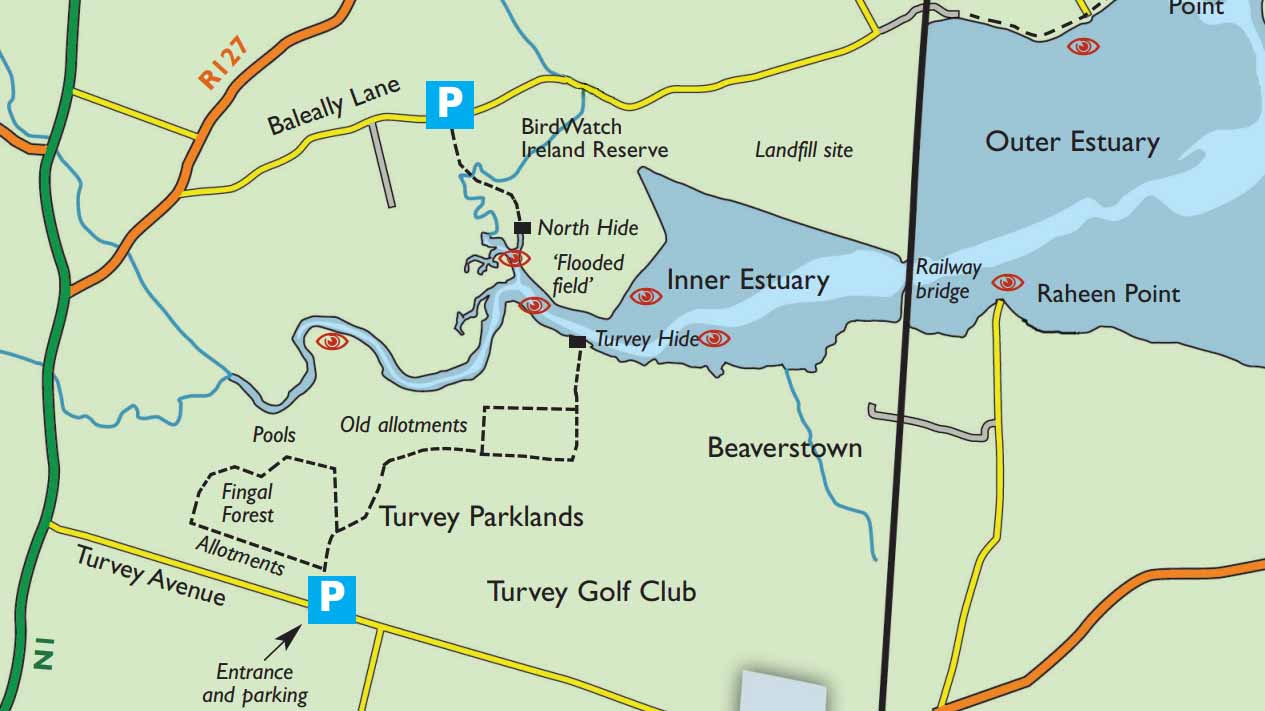Rogerstown Hide Roster
If you would like to volunteer for hide duty please contact:
Paul at bwifingal@gmail.comThe responsibilities of the person on hide duty include:
- Opening hours range between 10.00 am and 4.00 pm. You can leave the hide during that interval but you should try and make yourself available to the public for much of this period. If you do leave during this interval, close a few of the hatches and make sure the hide is accessible.
- Encourage all visitors to sign Visitors Book
- Record any rarities or large numbers of species in Log Book
- Keep an eye out for any unauthorised activities such as shooting/dumping etc.
- Make sure all hatches/doors are closed and secured when you finish your duty.

Due to the treat to its future many years ago Rogerstown estuary has become one of the Fingal branch's main focus for conservation. Thanks to the hard work of the branch an extension of the land fill further onto the inner estuary was stopped and in 1995 BWI purchased 30 acres of wetland habitat (including the flooded field) and entered management agreements with sympathetic land owners for a further 15 acres. In 1998 thanks to the co-operation of Fingal County Council a hide was erected on the south shore of the estuary on council land. It is a large cargo container fitted with a timber interior and raised 2 meters off the ground. Its been a phenomenal success with hundreds of birders from near and far visiting annually. Again due to the commitment of the branch members the hide is now wardened every Saturday and Sunday from September through to March.
Disturbing birds while roosting and feeding should be avoided. They can easily be viewed from the hides so do not approach on foot or on the water by canoe, kayak or other means. It is advisable not to enter the inner estuary on the water at any time.
Rogerstown estuary is designated as a Special Area of Conservation and a Special Protection Area as it is an important waterfowl site, with Brent Goose having a population of international importance. A further 16 species have populations of national importance: Greylag Goose, Shelduck , Teal, Pintail, Shoveler, Oystercatcher, Ringed Plover, Golden Plover, Grey Plover, Lapwing, Knot, Dunlin, Sanderling, Black-tailed Godwit, Curlew, Redshank and Greenshank. The presence of a significant population of Golden Plover is of note and this species is listed on Annex I of the E.U. Birds Directive. The estuary is a regular staging post for autumn migrants, especially Green Sandpiper, Ruff, Little Stint, Curlew Sandpiper and Spotted Redshank. Little Tern breed at the outer sand spit, but the nesting area has is under constant threat of being washed away as a result of erosion. Historically The maximum number of pairs recorded was 17 in 1991, but the nesting area was washed and very few nesting attempts were made in the following 15 years or so. In 2018 the branch setup a conservation project in conjunction with the County Council and NPWS which has been a great success. See our Little Tern page for more details. Ringed Plover, Skylark and Meadow Pipit breed in the same area. The outer part of the estuary has been designated a Statutory Nature Reserve and a Special Protection Area under the E.U. Birds Directive. The inner estuary has been damaged by the refuse tip which covers 40 ha of mudflat, but thankfully it closed for good in 2012 and is now Rogerstown Park. This site is a good example of an estuarine system, with all typical habitats represented, including several listed on Annex I of the E.U. Habitats Directive. Rogerstown is an internationally important waterfowl site and has been a breeding site for Little Terns. The presence within the site of three rare plant species adds to its importance.
Rogerstown is ~18km from the city centre on the M1/N1. The nearest bus service is the #33 from Eden Quay to the N1/Turvey Avenue junction. Donabate has a train service from Connolly Station via Howth Junction & Malahide. Donabate village is ~3.5km from the hide. The outer estuary is quite accessible by public road at Raheen Point, Donabate and The Burrow, Portrane on the southern side and at Rogerstown and Baleally Lane on the northern side. The inner estuary can be accessed from two points. If approached from Balleally Road, cross the style at parking place (limited to 1 or 2 cars) and take the right-of-way down to the reserve. Phone 087 289 3656 for lock access code. Visiting during spring tides is inadvisable as roosting birds may be disturbed and the visitor may be trapped on the reserve by the incoming tide. If approached from Turvey Avenue park at the Turvey Park car park and travel on foot to the main hide.
Both the hide's are located very close to the main roosting sites for the birds of the estuary and visitors should attempt to get into position 1-2 hours before high tide (this is especially the case for the Northern Hide due to the exposed approach to the hide, roosting birds are easily disturbed). Visitors should also refrain from entering the flooded field to minimize disturbance to feeding and roosting birds. All other lands in the inner estuary area are privately owned and permission should always be sought from landowners before entering.